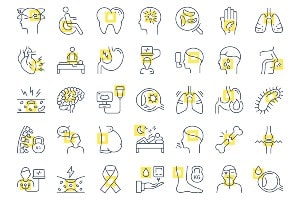About Low White Blood Cell Count (Neutropenia)

Learn about the disease, illness and/or condition Low White Blood Cell Count (Neutropenia) including: symptoms, causes, treatments, contraindications and conditions at ClusterMed.info.
Low White Blood Cell Count (Neutropenia)

| Low White Blood Cell Count (Neutropenia) |
|---|
Low White Blood Cell Count (Neutropenia) InformationNeutropenia definition and facts
Does neutropenia put a person at risk for bacterial infections?Neutropenia results in an increased susceptibility to bacterial infections. The degree of risk depends upon the cause and severity of the neutropenia, the underlying medical condition of the patient, and the presence or absence of bone marrow reserves for the production of neutrophils.The most common types of infection seen in neutropenic patients (patients with low white blood cell counts) are caused by bacteria normally found on the skin (such as Staphylococcus aureus) or from the gastrointestinal and urinary tract. Fungal infections are also more frequent in patients with neutropenia. The infections may be limited to certain areas of the body (commonly the oral cavity, genital area, and skin) or may spread via the bloodstream to the lungs and other organs in severe, prolonged neutropenia. How is neutropenia diagnosed?Neutropenia is diagnosed by a blood cell count performed on a sample of blood removed from a vein. To determine the specific cause of neutropenia in a given situation, other tests may be required. Sometimes a bone marrow biopsy may be required to diagnose the specific cause of neutropenia. What are normal neutropenia levels and ranges?The white blood cell count (WBC) is the number of white blood cells in a volume of blood. The normal range for the WBC varies slightly among laboratories but is generally between 4,300 and 10,800 cells per microliter or cubic millimeter (cmm). The WBC can also be referred to as the leukocyte count and can be expressed in international units as 4.3 x 109 to 10.8 x 109 cells per liter. The percentage of the different types of white blood cells in the WBC is called the WBC differential.The absolute neutrophil count (ANC) is determined by the product of the white blood cell count (WBC) and the fraction of neutrophils among the white blood cells as determined by the WBC differential analysis. For example, if the WBC is 10,000 per microliter and 70% are neutrophils, the ANC would be 7,000 per microliter.An ANC of less than 1500 per microliter (1500/microL) is the generally accepted definition of neutropenia. Neutropenia is sometimes further classified as:
What are the signs and symptoms of neutropenia?Signs and symptoms suggestive of neutropenia include:
What causes neutropenia?Neutropenia can be present (though it is relatively uncommon) in normal healthy individuals, notably in some persons of African or Arabic descent and Yemenite Jews. Neutropenia may arise as a result of decreased production of neutrophils, destruction of neutrophils after they are produced, or pooling of neutrophils (accumulation of the neutrophils out of the circulation).Neutropenia may arise as a result of numerous medical conditions:
What is neutropenia?Neutropenia is a condition in which the number of neutrophils in the bloodstream is decreased. Neutrophils are a type of white blood cell also known as polymorphonuclear leukocytes or PMNs. Neutropenia reduces the body's ability to fight off bacterial infections.White blood cells are also known as leukocytes. There are five major types of circulating white blood cells:
What is the treatment for neutropenia?Treatment of neutropenia is based upon the underlying cause, severity, and the presence of associated infections or symptoms as well as the overall health status of the patient. Obviously, treatment must also be directed toward any underlying disease process. Treatments that directly address neutropenia may include (note that all of these treatments may not be appropriate in a given setting):
|
More Diseases
A | B | C | D | E | F | G | H | I | J | K | L | M | N | O | P | Q | R | S | T | U | V | W | X | Y | Z
Diseases & Illnesses Definitions Of The Day
- Noncancerous Colloid Thyroid Nodule (Thyroid Nodules) ‐ How are thyroid nodules diagnosed?, Introduction to thyroid nodules …
- Skin, Laser Resurfacing (Laser Resurfacing) ‐ CO2 Laser Resurfacing, Complications of Laser Skin Resurfacing …
- Malignant Fibrous Histiocytoma (Bone Cancer Overview) ‐ Are there any treatments or medications that relieve bone cancer pain? …
- Double Vision ‐ Is it possible to prevent double vision?, What are the symptoms and signs of double vision? …
- Ageusia (Taste Disorders) ‐ Are taste disorders serious?, Can taste disorders be treated? …
- Autism Screening and Diagnosis ‐
- Alpha-fetoprotein Blood Test ‐ In which situations are high blood (serum) levels of AFP used as a tumor marker? …
- Polymyalgia Rheumatica ‐ How do health care professionals make a diagnosis of polymyalgia rheumatica? …
- Stump Appendicitis (Appendicitis) ‐ Appendicitis definition and facts, Are there long-term consequences of appendectomy? …
- Gonorrhea (Gonorrhea In Women) ‐ Gonorrhea facts, How is gonorrhea diagnosed?, What are sexually transmitted diseases (STDs)? …